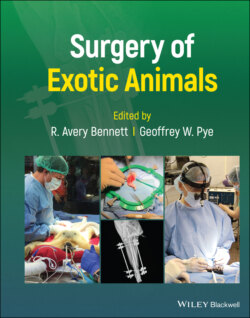Читать книгу Surgery of Exotic Animals - Группа авторов - Страница 90
Gastropod Mollusks
ОглавлениеThe gastropods belong in the phylum Mollusca and include over 60,000 marine, fresh water, and terrestrial species. The group includes abalone, conchs, nudibranchs, sea hares, slipper shells, slugs, snails, and whelks, among many others. They account for approximately 80% of all mollusk species. Gastropods have a ventrally flattened foot that provides locomotion along the various surfaces of their habitats. They are important display, food, and research animals. Some species are successfully cultured although wild capture is the most common method of procurement. They can be quite large and many are long‐lived. Investigators working on the sea hare, Aplysia, were awarded a Nobel Prize for medicine or physiology in 2000 for their work on neurophysiology, behavior, and learning. The Nobel Prize in Physiology or Medicine 2000. NobelPrize.org. Nobel Prize Outreach AB 2021 (https://www.nobelprize.org/prizes/medicine/2000/summary/ accessed Mon. 2 Aug 2021). These factors and others make them important animals for veterinary consideration.
There is very little in the literature on gastropod surgery. Much of what is published deals with the amputation of structures like eyes and tentacles, and the surgical compromise of neural tissue to study regeneration (Moffett 2000; Tartakovskaya et al. 2003; Matsuo et al. 2010a,b). These procedures generally do not require wound closure or postoperative therapy. Anderson et al. (2010) determined that silk, among the five suture materials (braided silk, monofilament nylon, monofilament polylecaprone, polydioxanone, and polyglactin 910) tested in the skin of Aplysia californica, resulted in the least amount of granuloma formation. The amount of tissue reaction did not differ among the various sutures.
Figure 4.4 This image illustrates the major external anatomical features of a terrestrial shelled gastropod.
With regards to hard tissue surgery, there is a case report of shell repair in an apple snail, Pomacea bridgesii (Lewbart and Christian 2003). Apple snails are common in the pet trade and a number of species are maintained in aquariums globally. The shell of a typical gastropod contains the apex, spire (made up of whorls), and the body whorl, which terminates at the aperture (Figure 4.4). The head and foot of the snail protrude from the aperture. The oldest whorls are those closest to the apex of the shell. The gastropod shell is composed of four layers. The outer periostracum is composed of conchin, a horny protein, and the internal layers are composed of calcium carbonate and organic material (Ruppert and Barnes 1994). A mature female apple snail crawled out of its aquarium, fell to the floor, and fractured its shell. A depression fracture and a full‐thickness “U‐shaped” crack were noted on the body whorl (Figure 4.5).
The fractured shell and underlying tissues were flushed with sterile saline and an abrasive Dremel drill bit was used to roughen the surfaces on each side of the fracture. Epoxy (Epoxy Putty®, Oatey, Cleveland, OH) was used to construct a bridge that was attached with digital pressure (Figure 4.6). A section of transparent bandage (Tegaderm®, 3‐M) was secured to the shell over the area of the depression fracture. Three months later the shell was stable, but the defects remained. Since mollusks lay down shell at the free edges of the mantle, they cannot regenerate or remodel shell in other areas. The stability of the shell was most likely due to soft tissue healing beneath the fracture sites.
Figure 4.5 This apple snail (Ampullariidae) suffered a fractured shell after falling from its aquarium onto a firm substrate.
Figure 4.6 The same snail in Figure 4.5 after the application of an epoxy bridge and transparent bandage.
